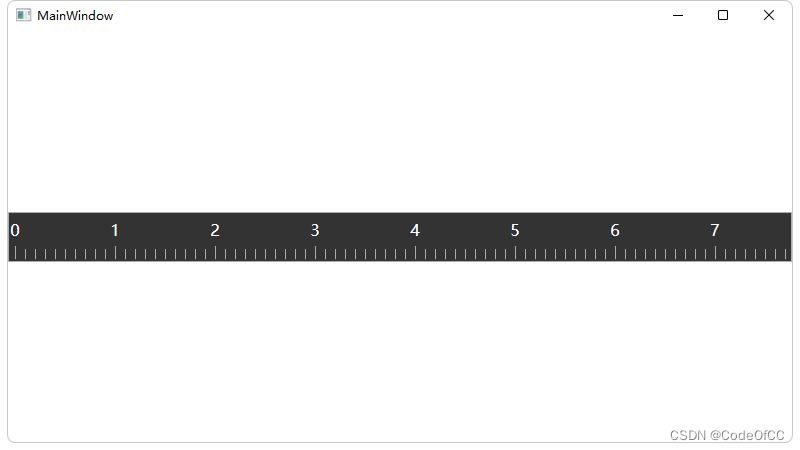前言
尺子在客户端开发中有一定的应用场景,比如厘米尺、白板的画线尺、视频剪辑的时间尺。一般可以采用用户控件通过自绘的方式实现,但今天我要讲一个不一样的方法,不使用自定义控件也不用用户控件,只需要ListBox即能实现一把尺子。
一、如何实现?
1、设置横向ListBox
我们实现一把水平的尺子,所以需要让ListBox横向显示
<ListBox.ItemsPanel>
<ItemsPanelTemplate>
<VirtualizingStackPanel Orientation="Horizontal"></VirtualizingStackPanel>
</ItemsPanelTemplate>
</ListBox.ItemsPanel>
2、Item设为刻度样式
一个Item就是一个刻度,我们通过ItemTemplate的方式设置样式。
<ListBox.ItemTemplate>
<DataTemplate>
<StackPanel Width="10" Height="46" Orientation="Vertical" Background="Transparent">
<TextBlock x:Name="text" Margin="0,6,0,6" HorizontalAlignment="Center" FontSize="16" Text="{Binding Number}" Foreground="#ffffff" Visibility="{Binding NumberVisibility}"></TextBlock>
<Line x:Name="line" HorizontalAlignment="Center" Height="20" Width="5" X1="2.5" Y1="0" X2="2.5" Y2="25" StrokeThickness="1" Stroke="#aaaaaa"></Line>
</StackPanel>
</ListBox.ItemTemplate>
3、绑定数据源
由于ListBox是基于数据集合来显示控件的,我们通过绑定数据源让其显示刻度。
<ListBox ItemsSource="{Binding Chips}">
public class RulerChip
{
public double Number { get; set; }
public Visibility NumberVisibility { get; set; }
}
public List<RulerChip> Chips { get; set; }=new List<RulerChip>();
二、完整代码
MainWindow.xaml
<Window x:Class="WpfApp7.MainWindow"
xmlns="http://schemas.microsoft.com/winfx/2006/xaml/presentation"
xmlns:x="http://schemas.microsoft.com/winfx/2006/xaml"
xmlns:d="http://schemas.microsoft.com/expression/blend/2008"
xmlns:mc="http://schemas.openxmlformats.org/markup-compatibility/2006"
xmlns:local="clr-namespace:WpfApp7"
mc:Ignorable="d"
Title="MainWindow" Height="450" Width="800">
<Grid>
<ListBox Background="#333333" Height="50" ItemsSource="{Binding Chips}" ScrollViewer.HorizontalScrollBarVisibility="Disabled" >
<ListBox.ItemContainerStyle>
<Style TargetType="{x:Type ListBoxItem}">
<Setter Property="Template">
<Setter.Value>
<ControlTemplate TargetType="{x:Type ListBoxItem}">
<ContentPresenter
Content="{TemplateBinding Content}"
ContentStringFormat="{TemplateBinding ContentStringFormat}"
ContentTemplate="{TemplateBinding ContentTemplate}" />
</ControlTemplate>
</Setter.Value>
</Setter>
</Style>
</ListBox.ItemContainerStyle>
<ListBox.ItemsPanel>
<ItemsPanelTemplate>
<VirtualizingStackPanel Orientation="Horizontal"></VirtualizingStackPanel>
</ItemsPanelTemplate>
</ListBox.ItemsPanel>
<ListBox.ItemTemplate>
<DataTemplate>
<StackPanel Width="10" Height="46" Orientation="Vertical" Background="Transparent">
<TextBlock x:Name="text" Margin="0,6,0,6" HorizontalAlignment="Center" FontSize="16" Text="{Binding Number}" Foreground="#ffffff" Visibility="{Binding NumberVisibility}"></TextBlock>
<Line x:Name="line" HorizontalAlignment="Center" Height="20" Width="5" X1="2.5" Y1="0" X2="2.5" Y2="25" StrokeThickness="1" Stroke="#aaaaaa"></Line>
</StackPanel>
<DataTemplate.Triggers>
<DataTrigger Binding="{Binding NumberVisibility}" Value="Hidden">
<Setter TargetName="line" Property="Y1" Value="3" />
</DataTrigger>
<Trigger Property="IsMouseOver" Value="True">
<Setter TargetName="line" Property="Stroke" Value="RoyalBlue" />
<Setter TargetName="text" Property="Foreground" Value="RoyalBlue" />
</Trigger>
</DataTemplate.Triggers>
</DataTemplate>
</ListBox.ItemTemplate>
</ListBox>
</Grid>
</Window>
MainWindow.xaml.cs
using System.Collections.Generic;
using System.Windows;
namespace WpfApp7
{
public class RulerChip
{
public double Number { get; set; }
public Visibility NumberVisibility { get; set; }
}
/// <summary>
/// Interaction logic for MainWindow.xaml
/// </summary>
public partial class MainWindow : Window
{
public List<RulerChip> Chips { get; set; }=new List<RulerChip>();
public MainWindow()
{
InitializeComponent();
DataContext = this;
for (int i = 0; i < 100; i++)
{
Chips.Add(new RulerChip() { Number=i/10.0, NumberVisibility = (i%10==0)?Visibility.Visible:Visibility.Hidden});
}
}
}
}
三、效果预览

总结
以上就是今天要讲的内容,本文仅仅简单介绍了ListBox实现尺子控件的方法,很容易实现。而且因为使用了虚拟化容器理论上性能很好,就算是几百万刻度绘制也估计不会卡顿。所以在此基础上可以进行一定的拓展,比如利用dpi实现物理尺子,以及实现时间尺的缩放功能等。总的来说,这是一个易于实现且拓展性也不错的尺子实现方案。























 785
785











 被折叠的 条评论
为什么被折叠?
被折叠的 条评论
为什么被折叠?










